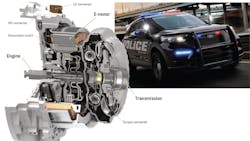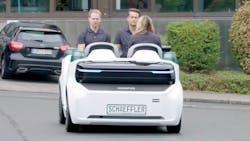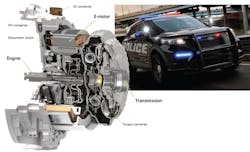As the number of electric and hybrid-electric vehicles increases and their use spreads, it becomes more important for lubrication/tribology firms to explore and develop the lubricants and fluids these vehicles will need.
“On an absolute basis, electric vehicles need less lubricants and additives,” says Jeff Hemphill, CTO of Schaeffler Group, an automotive supplier. “But where does the energy get used in electric vehicles compared to conventional ones? Does this make lubrication more important or less important? Where are the points of friction, and could unconventional approaches work better than simply adopting lubricants and fluids that internal-combustion vehicles rely on?”
Before answering those questions, here’s a quick look at some of the trends paving the way for electric vehicles.
EV Use
There are five factors making EVs more popular among consumers, according to John Burke, CMFS, global director of engineering services, Quaker Houghton:
- Advances in batteries that increase the travel distance between recharging, making them viable options for daily commuters. The cost of original and replacement batteries has also come down.
- Energy cost per mile is now lower for electric cars than conventional ones.
- The perception of less maintenance.
- Near-zero onboard emissions.
- The cost for electric vehicles has come down.
“Investments in information campaigns and general education of the consumers are also driving adoption,” Burke says. “The more people learn about electric cars, the more comfortable they become with them. Plus, variety is increasing.
“There are more options, brands and suppliers participating and providing more choices,” he continued. “You can now get an electric SUV, and soon pickup trucks will be available. Not long ago, options were limited to just small cars.”
EV Lubricant Issues
What do lubricant specialists say will be the major differences in lubricant use between EVs and internal-combustion-powered cars and trucks?
“The lubricants and fluids in EVs will have some new jobs to do,” Hemphill says. “For example, automatic transmission fluid in today’s conventional vehicles must handle controlled friction in wet clutch packs, remove heat from the clutches and do both for more than 100,000 miles.
“In electric axle gearboxes, heat might need to be removed from the electric motor and there will likely be no clutch packs,” he added. “This might make the transmission fluid’s viscosity and specific heat more important than its ability to reduce or change friction.”
Ali Erdemir, professor of mechanical engineering and materials at Texas A&M University, agrees. “There are fewer moving components in EVs, so there are fewer types of lubricants needed,” Erdemir said. “These might differ from those used in internal-combustion engines, mainly because of the differences in contact load, speed and heat, which may call for better anti-wear, anti-scuff capabilities.”
“Electric vehicles have no combustion processes to deal with, so there is no engine oil in the conventional sense,” adds Edward P. Becker, P.E., president and founder of Friction & Wear Solutions, LLC. “This is the biggest change. However, EVs still use many of the same lubricants.
“For example, greases for wheel bearings, suspension components and body closures are essentially the same,” he explains. “To date, all EVs use conventional transmission fluids to lubricate the motor and gears. A new lubricant designed for high loads at low speeds will be required for future EVs.”
Burke concurs: “Electric cars can accelerate faster than conventional cars; therefore, they may put more stress on lubricants in powertrain components.”
There are also other new issues driven by high speeds in EVs’ axle gearboxes, according to Hemphill. These include bearing creep, in which a bearing’s outer race rotates in the housing. This calls for surface coatings or tribological solutions.
Another lubricant challenge is the presence of high voltages in the gearbox. Due to power switching for controlling electric motors, static charges build and are sometimes discharged through the bearings or gears. “In this case, the lubricant becomes the dielectric in a capacitor,” Hemphill says. “A variety of fixes are being explored, including insulation, modifying the lubricant modification and shunts.”
Another difference in EVs’ lubricant, according to Hemphill, is that their friction losses are a bigger percentage of the vehicle’s on-board energy than in conventional cars, and this makes drag reduction even more important.
The type of lubricants needed in some EVs could also change if ride-sharing grows and personal ownership of vehicles declines, Hemphill points out. “Ride-sharing vehicles will be more like taxis and be used 50 to 60% of the day. Most cars today are only used 4 to 5% of the say. This will make powertrain durability more important.”
Other EV Fluids
There are some fluids that will not be needed, or at least not as much, in EVs: antifreeze for the radiator, motor oil, automatic transmission fluid and rear differential gear oil. These fluids will not be used except for a possible small amount of heat-transfer fluid for the battery pack and electric motor. Also, with EVs’ regenerative braking, the strain on brake fluid will be less, though, admittedly, this is a small volume for each vehicle. Overall, the volume of lubricants in EVs will be lower than for today’s cars and trucks.
Fluids used to manufacture EVs will differ from those used to make conventional cars and trucks. For example, EVs simply do not need radiators, exhaust pipes, catalytic converters, engine blocks, pistons, camshafts, connecting rods, crankshafts, drive shafts, transmissions, clutches or associated gears and components.
And if the EV has a motor on each wheel, it will not need a rear differential (assuming an electric motor is used at each drive wheel). That means the need for metalworking fluids will decrease, says Burke. “Therefore, there will be a reduction in stamping/forming fluids, straight cutting oils, water-dilutable cutting fluids, heat treat quenchants, in-process and interim corrosion-prevention fluids and cleaning,” he says. “The burden to dispose of such fluids also will decline.”
Technological Changes
Lubricants will also be needed that can handle the innovations that change how EVs (as well as autonomous EVs) are designed. For example, designers at the Schaeffler Group ae working on a robo-taxi with four 90-deg. steerable wheels, each with a planetary gearbox. The vehicle will use gearboxes, creating a significant demand for lubrication.
Schaeffler is also working with Paravan to develop and deploy drive-by-wire systems which were originally built to let people with handicaps drive. “This technology was quickly adopted by several automotive and industrial OEMs as they created autonomous vehicles because it offers ‘fail functional’ reliability in both electro-mechanical and electrical components,” says Schaeffler’s Hemphill. “We are now developing a high-volume version of this that we call SpaceDrive III. It will include actuators and our custom electric motor, which are built into the gearbox. They will have the same tribological challenges as electric axles.”
“Tribology and lubricants will remain relevant and important regardless of the increase in EVs on the road,” notes Erdemir. “After all, they all rely on moving parts such as bearings and gears to operate reliably and efficiently.”
This article was written by technical writer Jeanna Van Rensselar. A slightly different version of it first appeared in Tribology & Lubrication Technology, the monthly magazine of the Society of Tribologists and Lubrication Engineers, an international not-for-profit professional society headquartered in Park Ridge, Ill.



